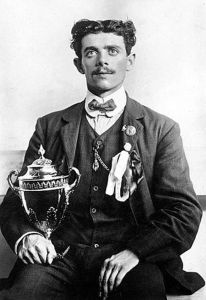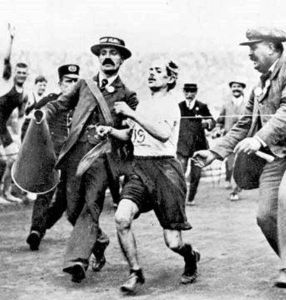Athlete
 He was born on 16th October 1885 in Mandrio, a hamlet of Correggio, into a family of farmers. In 1897 his father Desiderio left the fields to open a fruit and vegetable shop in nearby Carpi, where he moved with his wife and four children. Dorando started working very soon, as an apprentice in a pastry shop. In his spare time he devoted himself to cycling or running. He was a small man of small stature (1.59 m).
He was born on 16th October 1885 in Mandrio, a hamlet of Correggio, into a family of farmers. In 1897 his father Desiderio left the fields to open a fruit and vegetable shop in nearby Carpi, where he moved with his wife and four children. Dorando started working very soon, as an apprentice in a pastry shop. In his spare time he devoted himself to cycling or running. He was a small man of small stature (1.59 m).
In September 1904 the most famous Italian runner of the time, Pericle Pagliani, took part in a race in Carpi. It is said that Pietri, attracted by the event, started running behind Pagliani, still wearing his work clothes, and held his pace until the finish line. A few days later, Pietri made his debut in an official competition, running the 3000 metres in Bologna and finishing second.
The following year the first successes arrived, both in Italy and abroad, the most important of which was the 30 km of Paris, won with a gap of 6 minutes.
After the numerous victories obtained during the years 1906 and 1907, Dorando Pietri was the absolute dominator of the national fund, able to win from the middle distance to the marathon, and had already achieved important results on the international scene.
1908 was the year of the London Olympics. Dorando Pietri had been preparing for the event for months. On 7 July he earned his place in the Italian team in a 40 km marathon run in Carpi. He won in 2 hours and 38 minutes, a performance never achieved before in Italy.
The Olympic marathon was scheduled a few days later, on 24 July. For the first time the route covered 42.195 km.
At the start, in front of Windsor Castle, there were 56 athletes, including the two Italians: Dorando Pietri, white T-shirt and red shorts, with the number 19 on his chest, and Umberto Blasi. It was an unusually hot day for the English climate.
At 2:33 p.m. the Princess of Wales kicked off. Dorando remained at the back, waiting for the first ones, who started at a high pace, to get tired and so it happened that at the 39th kilometre she took the lead. There were now a couple of kilometres to go before the finish, but Pietri found himself having to deal with the enormous expenditure of energy made during the comeback and the dehydration due to the heat. Tiredness made him lose lucidity. When he arrived at the stadium, he took the wrong road. The judges made him go back, but Pietri fell to his death. He got up with their help, but now exhausted, he could hardly stand on his own feet.
He was only 200 metres from the finish line. The over 75,000 spectators in the stadium were all anxious for him. Around him on the track the race judges and even some doctors rushed to help him. Pietri fell four more times, and he was helped to get up four more times, but he continued to stagger forward towards the finish line. When he finally managed to cross the finish line, supported by a judge and a doctor, he was totally exhausted. His final time was 2h54'46"4 over 42,195 km, but it took him almost ten minutes just to cover the last 500 meters. Beyond the finish line he fainted and was carried off the track on a stretcher. Shortly after him came the American Johnny Hayes. The American team immediately filed a complaint for the help received by Pietri, which was promptly accepted. The correggese was disqualified and cancelled from the finish order of the race.
His final time was 2h54'46"4 over 42,195 km, but it took him almost ten minutes just to cover the last 500 meters. Beyond the finish line he fainted and was carried off the track on a stretcher. Shortly after him came the American Johnny Hayes. The American team immediately filed a complaint for the help received by Pietri, which was promptly accepted. The correggese was disqualified and cancelled from the finish order of the race.
The drama of Dorando Pietri moved all the spectators in the stadium. Almost to compensate him for the missed Olympic medal, Queen Alessandra awarded him with a gilded silver cup. To propose the award would have been the writer Arthur Conan Doyle, creator of the famous investigator Sherlock Holmes, who was present in the stands, a few metres from the finish line, since he had been commissioned by Lord Northcliffe to write the race report for the Daily Mail; the reporter-writer's report ended with the words:
« The great feat of the Italian can never be deleted from the sports archives, whatever the judges' decision may be ».
Subsequently, Conan Doyle suggested to the Daily Mail that Pietri receive a cash prize in the form of a subscription to allow him to open a bakery once he returned to Italy. The proposal was successful and three hundred pounds was raised. Doyle himself started the collection by donating five pounds.
The story of his heroic but unfortunate enterprise immediately went around the world. From one day to the next Dorando Pietri became a celebrity, in Italy and abroad. His deeds struck the imagination of the composer Irving Berlin, who even dedicated a song called Dorando to him.
Paradoxically, the missed Olympic victory was the key to his success. In the wake of his fame, he soon received a large contract for a series of competitions and exhibitions in the United States.
These were the golden years of endurance challenges, created by entrepreneurs from the entertainment world: they organised very long boxing, rowing and running competitions. Among these, the marathon had a place of honour, recreated a few years earlier as the crowning event of the Olympics, capable of taking men to extremes in a gruelling struggle against fatigue. It was not uncommon to see thousands of people running to watch races lasting several hours.
On 25 November 1908, at Madison Square Garden in New York, a rematch between Pietri and Hayes was staged. The attraction was enormous: twenty thousand spectators (including many Italian-Americans), but another ten thousand people remained outside because there were no more tickets.
The two athletes competed on the track over the distance of the marathon (262 laps), and after running head to head for almost the entire race, in the end Pietri managed to win by breaking Hayes in the last 500 metres, to the immense joy of the immigrants of Italian origin present. With this race Pietri officially switched to professional racing, in a climate that strongly distinguished the amateur athlete from the paid one, separating races and results of the two categories.
A second challenge held on 15 March 1909 was also won by the Italian. During his trip to the United States, Pietri took part in 22 races, with distances varying from 10 miles to the marathon, and won 17. Among the athletes he faced was also Tom Longboat, the strongest North American on the marathon. Pietri returned to Italy in May 1909, and continued his professional activity at national and international level for another two years. His last marathon was in Buenos Aires, on 24 May 1910, where he closed with his personal record, 2h38'48"2.
The farewell race, in Italy, took place on 3 September 1911 in Parma: a 15 km race, easily won. The last race abroad took place on 15 October of the same year, in Gothenburg, Sweden, and ended with yet another victory for Pietri. The next day he turned 26 years old. In three years of professionalism and 46 races, Dorando Pietri earned over 200,000 lire in prizes alone, a huge sum for the time. In addition, he received a weekly per diem of 1250 lire from his agent.
He invested his earnings in a hotel business together with his brother, but as an entrepreneur he did not show the same talent he had as a sportsman. After the bankruptcy of the hotel, he moved to Sanremo in 1923, where he opened a garage. He lived the rest of his life in the city of flowers.
Pietri died on 7 February 1942, at the age of 56, of a heart attack. He was buried in the cemetery of Valle Armea, near Sanremo.
The cup donated to Pietri by Queen Alessandra is today kept by the "Società Ginnastica La Patria 1879" in a safe deposit box of the Unicredit branch in Carpi (MO), in the same building that was the "Grand Hotel Dorando". This dedication is engraved on the trophy:
« To Pietri Dorando - In memory of the Windsor marathon at the stadium - 24 July 1908. From Queen Alessandra ».
(text taken and elaborated by Wikipedia)




